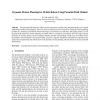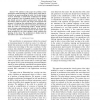17 search results - page 1 / 4 » A Behavior Architecture for Autonomous Mobile Robots Based o... |
ROBOCUP
2004
Springer
13 years 10 months ago
2004
Springer
Abstract. This paper describes a behavior-based architecture which integrates existing potential field approaches concerning motion planning as well as the evaluation and selectio...
AROBOTS
2002
13 years 4 months ago
2002
The potential field method is widely used for autonomous mobile robot path planning due to its elegant mathematical analysis and simplicity. However, most researches have been focu...
WSC
2000
13 years 6 months ago
2000
Micro-robots will soon be available for deployment by the thousands. Consequently, controlling and coordinating a force this large to accomplish a prescribed task is of great inte...
ICRA
1993
IEEE
13 years 8 months ago
1993
IEEE
A control system architecture is described for an autonomous flying vehicle. The vehicle, equipped with fourteen sensors, uses a model helicopter as an airframe. The control syste...
ROMAN
2007
IEEE
13 years 11 months ago
2007
IEEE
— We address in this paper the problem of the autonomous online learning of a sensory-motor task, demonstrated by an operator guiding the robot. For the last decade, we have deve...


